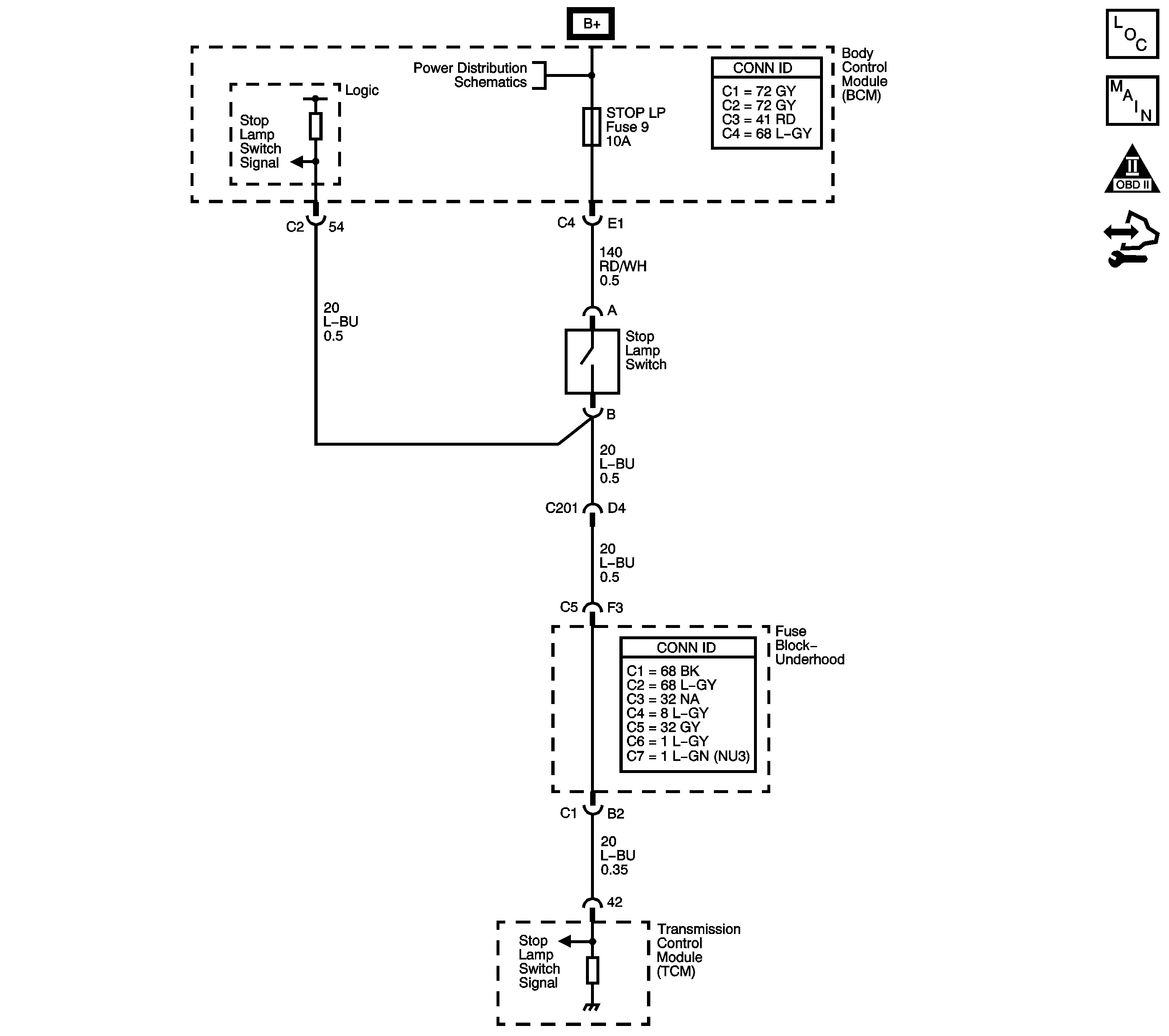
Circuit Description
The brake switch indicates brake pedal status to the transmission control module (TCM). The normally-closed brake switch supplies ignition voltage to the TCM. Applying the brake pedal opens the switch, interrupting voltage to the TCM. Releasing the brake pedal resumes voltage to the TCM.
When the TCM detects an open brake switch, stuck OFF, during decelerations, then DTC P0719 sets. DTC P0719 is a type C DTC.
DTC Descriptor
This diagnostic procedure supports the following DTC:
DTC P0719 Brake Switch Circuit Low Voltage
Conditions for Running the DTC
| • | No OSS DTCs P0722 or P0723. |
| • | DTC P0719 has not passed this key cycle. |
Conditions for Setting the DTC
DTC P0719 sets if the TCM detects an open brake switch or circuit and the following conditions occur eight times:
| • | The vehicle speed is greater than 32 km/h (20 mph) for 6 seconds; |
| • | then, the vehicle speed is 8-32 km/h (5-20 mph) for 6 seconds; |
| • | then, the vehicle speed is less than 8 km/h (5 mph) for 2 seconds. |
Action Taken When the DTC Sets
| • | The TCM does not illuminate the malfunction indicator lamp (MIL). |
| • | The TCM disregards the brake switch input for TCC scheduling. The TCM then uses throttle position and vehicle speed inputs to determine TCC application and release. Use of these inputs may result in a noticeable harsh apply or abrupt release of the TCC. |
| • | The TCM records the operating conditions when the Conditions for Setting the DTC are met. The TCM stores this information as Failure Records. |
| • | The TCM stores DTC P0719 in TCM history. |
Conditions for Clearing the DTC
| • | A scan tool can clear the DTC. |
| • | The TCM clears the DTC from TCM history if the vehicle completes 40 warm-up cycles without a non-emission related diagnostic fault occurring. |
| • | The TCM cancels the DTC default actions when the fault no longer exists and the DTC passes. |
Test Description
The numbers below refer to the step numbers on the diagnostic table.
-
Disconnecting the brake switch connector jumping the circuit, and observing a status change, isolates the brake switch as the source of the DTC.
-
If the ignition 1 voltage circuit shorts to ground, the STOP LPS fuse opens.
-
If the brake switch is properly adjusted, then the brake switch must be replaced.
-
Replace the TCM only after you have completed the preceding diagnostic steps.
Step | Action | Yes | No | ||||||
|---|---|---|---|---|---|---|---|---|---|
1 | Did you perform the Diagnostic System Check - Vehicle? | Go to Step 2 | |||||||
Important: Before clearing the DTC, use the scan tool in order to record the Failure Records. Using the Clear Info function erases the Failure Records from the TCM. Did the brake switch status change from Open to Closed? | Go to Step 5 | Go to Step 3 | |||||||
Refer to Circuit Protection - Fuses . Is the fuse open? | Go to Step 4 | Go to Step 6 | |||||||
4 |
Important: The condition that affects this circuit may exist in other connecting branches of the circuit. Refer to Power Distribution Schematics for complete circuit distribution. Test the ignition 1 voltage circuit of the brake switch for a short to a ground. Refer to Testing for Short to Ground and Wiring Repairs . Did you find and correct the condition? | Go to Step 9 | -- | ||||||
Refer to Stop Lamp Switch Adjustment . Did the brake switch require adjustment? | Go to Step 9 | Go to Step 7 | |||||||
6 |
Refer to Testing for Continuity and Wiring Repairs . Did you find and correct a condition? | Go to Step 9 | Go to Step 8 | ||||||
7 | Replace the brake switch. Refer to Stop Lamp Switch Replacement . Did you complete the replacement? | Go to Step 9 | -- | ||||||
Replace the TCM. Refer to Control Module References for replacement, setup, and programming. Did you complete the replacement? | Go to Step 9 | -- | |||||||
9 | Perform the following procedure in order to verify the repair:
Has the test run and passed? | Go to Step 10 | Go to Step 2 | ||||||
10 | With the scan tool, observe the stored information, capture info and DTC info. Does the scan tool display any DTCs that you have not diagnosed? | System OK |
